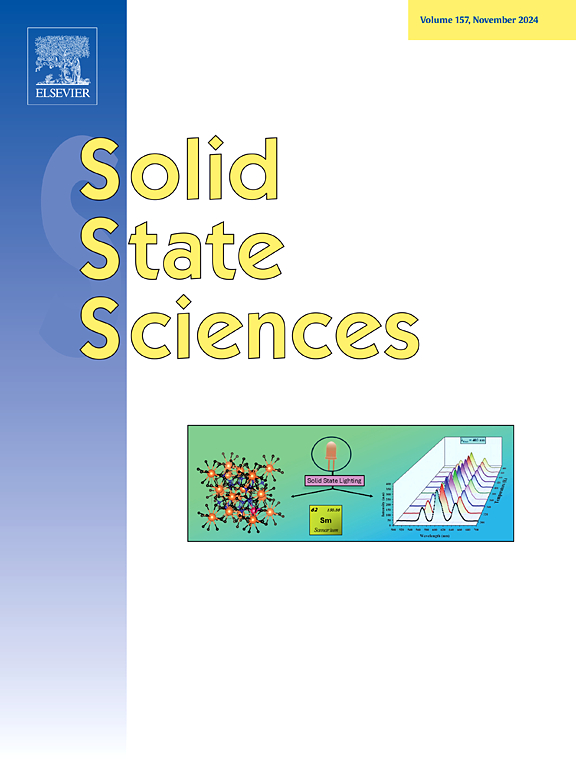熔融纺丝法制备Zn/Sc共掺杂GeTe的热电性能
IF 3.4
3区 化学
Q2 CHEMISTRY, INORGANIC & NUCLEAR
引用次数: 0
摘要
热电材料由于其优异的热电性能而受到广泛的关注。本文采用熔融纺丝与热压相结合的方法制备了GeTe样品。与传统熔融法制备的样品相比,该样品具有较低的载流子浓度,并且晶界散射增强导致导热系数降低。锌的掺杂增加了态的有效质量密度,在保持高迁移率的同时提高了塞贝克系数。Ge1-xZnxTe样品中点缺陷和层错的声子散射加剧导致晶格热导率显著降低,在775 K时最小值仅为~ 0.51 Wm−1K−1。Ge0.98Zn0.02Te样品在775 K时达到最大zT ~ 1.4。进一步引入Sc不仅增强了多尺度微结构的声子散射,降低了晶格热导率,使晶格热导率最低,为~ 0.29 Wm−1K−1,而且提高了维氏硬度,比Zn掺杂样品提高了约43%。本工作证明了Zn和Sc共掺杂的GeTe样品是一种具有实际应用价值的优良热电材料。本文章由计算机程序翻译,如有差异,请以英文原文为准。

Thermoelectric properties of Zn/Sc codoped GeTe prepared by melt-spinning method
GeTe thermoelectrics have received widespread attention due to their excellent thermoelectric performance. In this paper, GeTe samples are prepared by a melt spinning process combined with hot-pressing. The samples have a lower carrier concentration compared to those prepared by the traditional melting method, and the enhanced grain boundary scattering leads to a reduction in thermal conductivity. Zn doping is found to increase the density of states effective mass, leading to an enhanced Seebeck coefficient while maintaining a high mobility. The intensified phonon scattering of point defects and stacking faults in Ge1-xZnxTe samples leads to significantly reduced lattice thermal conductivity, with a minimum value of only ∼0.51 Wm−1K−1 at 775 K. The Ge0.98Zn0.02Te sample achieves a maximum zT∼1.4 at 775 K. The further introduced Sc not only enhances the phonon scattering from multi-scale microstructures to reduce the lattice thermal conductivity, resulting in the lowest value of ∼0.29 Wm−1K−1, but also improves the Vickers hardness, which is about 43 % higher than the Zn doped samples. This work demonstrates the Zn and Sc co-doped GeTe samples as excellent thermoelectric materials for practical applications.
求助全文
通过发布文献求助,成功后即可免费获取论文全文。
去求助
来源期刊

Solid State Sciences
化学-无机化学与核化学
CiteScore
6.60
自引率
2.90%
发文量
214
审稿时长
27 days
期刊介绍:
Solid State Sciences is the journal for researchers from the broad solid state chemistry and physics community. It publishes key articles on all aspects of solid state synthesis, structure-property relationships, theory and functionalities, in relation with experiments.
Key topics for stand-alone papers and special issues:
-Novel ways of synthesis, inorganic functional materials, including porous and glassy materials, hybrid organic-inorganic compounds and nanomaterials
-Physical properties, emphasizing but not limited to the electrical, magnetical and optical features
-Materials related to information technology and energy and environmental sciences.
The journal publishes feature articles from experts in the field upon invitation.
Solid State Sciences - your gateway to energy-related materials.
 求助内容:
求助内容: 应助结果提醒方式:
应助结果提醒方式:


